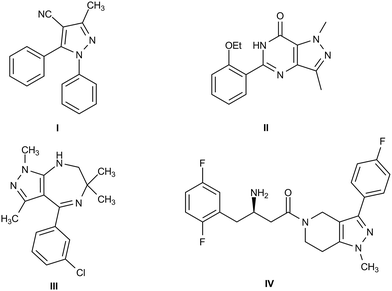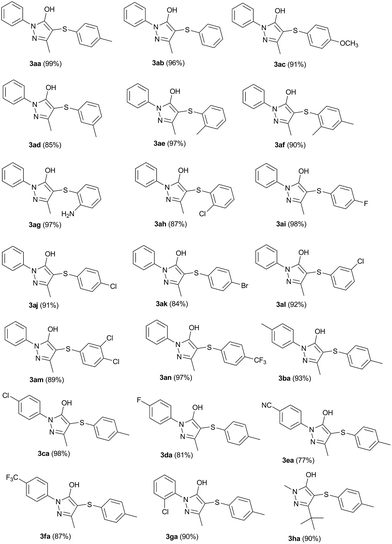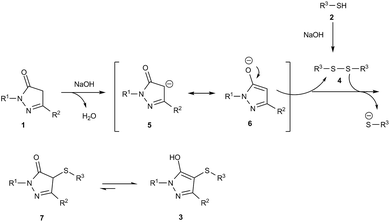Metal-free direct construction of sulfenylated pyrazoles via the NaOH promoted sulfenylation of pyrazolones with aryl thiols†
Xiaoxia Liu‡
,
Huanhuan Cui‡,
Daoshan Yang,
Shicui Dai,
Tiantian Zhang,
Jingyu Sun,
Wei Wei* and
Hua Wang*
The Key Laboratory of Life-Organic Analysis and Key Laboratory of Pharmaceutical Intermediates and Analysis of Natural Medicine, School of Chemistry and Chemical Engineering, Qufu Normal University, Qufu 273165, Shandong, China. E-mail: weiweiqfnu@163.com; huawang_qfnu@126.com; Web: http://www.wang.qfnu.edu.cn
First published on 23rd May 2016
Abstract
A convenient and cost-effective NaOH-promoted direct sulfenylation of pyrazolones with aryl thiols has been developed under mild and metal-free conditions. In this transformation, a range of valuable sulfenylated pyrazoles can be easily achieved in moderate to excellent yields, with high atom efficiency and good functional group tolerance.
Pyrazole and its derivatives, an important class of heterocyclic compounds, have been widely used in the medicinal and agrochemical industry due to their diverse pharmacological and biological activities.1 For example, they have been recognized as an antibacterial agent,2 histone deacetylase inhibitor,3 HIV-1 reverse transcriptase inhibitor (Fig. 1, compound I),4 the inhibitor of type 5 cGMP phosphodiesterase (Fig. 1, compound II),5 antidepressant zometapine (Fig. 1, compound III),6 the inhibitor of dipeptidyl peptidase IV (DPP-IV) (Fig. 1, compound IV),7 and many agrochemicals such as insecticides and herbicides.8 Consequently, substantial efforts have been devoted to the construction of various pyrazole derivatives.9 Particularly, the interest in sulfenylated pyrazoles has increased due to their proven usefulness as the herbicidal agents10 and antioxidants.11 Generally, sulfenylated pyrazoles were prepared by the nucleophilic substitution reaction of sodium thiolate with bromopyrazolones, the cyclization reaction of methyl 3-oxo-2-(phenylthio)butanoate with phenylhydrazine,11,12 and the sulphenylation of pyrazolones with preformed and unstable sulphenyl chlorides.12 However, most of these reactions suffer from certain limitations, such as the need for prefunctionalized sulfenylating reagents, multiple-step operation, relatively harsh reaction conditions, and low atom economy. Therefore, the development of a simple, convenient and efficient strategy for the synthesis of sulfenylated pyrazoles is still highly desirable.
 | (1) |
 | (2) |
 | (3) |
In 2014, Zhao and Lu presented an elegant work for p-toluenesulphonic acid-promoted, I2-catalysed sulphenylation of pyrazolones with aryl sulphonyl hydrazides for the synthesis of sulfenylated pyrazoles in i-PrOH at 120 °C (eqn (1)).13 Very recently, Purohit et al. have reported the palladium N-heterocyclic carbene catalyzed sulphenylation of 1-aryl-3-methyl-1H-pyrazol-5(4H)-ones with aryl thiols leading to sulfenylated pyrazoles (eqn (2)).14 Nevertheless, the above two well established methods still have some disadvantages of high reaction temperature, limited substrate scope, or the use of expensive and toxic transition metal catalysts, which may limit their wide applications in organic synthesis and medicinal chemistry. With our continuous efforts in the synthesis of sulfur-containing compounds,15 herein, we wish to report a new strategy for the facile and highly efficient synthesis of sulfenylated pyrazoles through the NaOH-promoted direct sulfenylation of pyrazolones with various commercial available aryl thiols under metal- and additive-free conditions at 60 °C (eqn (3)).
In an initial experiment, the sulfenylation reaction of 3-methyl-1-phenyl-1H-pyrazol-5(4H)-one 1a with 4-methylbenzenethiol 2a was investigated by using a variety of bases in CH3CN at 50 °C (Table 1, entries 1–7). Among the various bases examined, NaOH was found to be the most effective one giving the desired product 3aa in 96% yield (Table 1, entry 4). Further screening of reaction temperature revealed that the best yield of 3aa (99%) was obtained when reaction was conducted at 60 °C and a lower reaction temperature led to a slightly lower yield of product (Table 1, entries 8–11). Next, to investigate the effects of solvent, the model reaction was performed in various polar and non-polar solvents at 60 °C using NaOH as the base. Among the solvents tested, CH3CN was the most suitable solvent for the present transformation (Table 1, entry 10). In contrast, a moderate amount of 3aa was obtained when the reaction was performed in THF or EtOH (Table 1, entries 12 and 13). Moreover, none or only a trace amount of product was detected in 1,4-dioxane, DME, H2O, DMF, DMSO, toluene, DCE, or EtOAc (Table 1, entries 14–21). Finally, the equivalent amounts of base were examined, 1.2 equiv. of NaOH was found the best choice (Table 1, entries 10, 22 and 23). In the absence of NaOH, no desired product was detected, which indicated that base was essential to this reaction (Table 1, entry 24).
| Entry | Base | Solvent | T (°C) | Yieldb (%) |
|---|---|---|---|---|
| a Reaction conditions: 1a (0.25 mmol), 2a (0.375 mmol), base (0.3 mmol), solvent (2 mL), 25–70 °C, air, 2 h.b Isolated yields based on 1a.c NaOH (0.25 mmol).d NaOH (0.5 mmol). | ||||
| 1 | KOH | CH3CN | 50 | 77 |
| 2 | K2CO3 | CH3CN | 50 | 80 |
| 3 | Na2CO3 | CH3CN | 50 | 0 |
| 4 | NaOH | CH3CN | 50 | 96 |
| 5 | Et3N | CH3CN | 50 | 61 |
| 6 | DBU | CH3CN | 50 | 94 |
| 7 | Pyridine | CH3CN | 50 | 0 |
| 8 | NaOH | CH3CN | 25 | 67 |
| 9 | NaOH | CH3CN | 40 | 90 |
| 10 | NaOH | CH3CN | 60 | 99 |
| 11 | NaOH | CH3CN | 70 | 97 |
| 12 | NaOH | THF | 60 | 53 |
| 13 | NaOH | EtOH | 60 | 51 |
| 14 | NaOH | DMF | 60 | 0 |
| 15 | NaOH | DMSO | 60 | 0 |
| 16 | NaOH | Toluene | 60 | 0 |
| 17 | NaOH | DCE | 60 | 0 |
| 18 | NaOH | EtOAc | 60 | 0 |
| 19 | NaOH | 1,4-Dioxane | 60 | Trace |
| 20 | NaOH | DME | 60 | Trace |
| 21 | NaOH | H2O | 60 | Trace |
| 22 | NaOH | CH3CN | 60 | 76c |
| 23 | NaOH | CH3CN | 60 | 99d |
| 24 | — | CH3CN | 60 | 0 |
With the optimized conditions in hand, the scope of this sulfenylation reaction was examined by conducting a variety of pyrazolones and thiols. As shown in Table 2, aryl thiols which have electron-donating or withdrawing groups on the aryl rings were suitable for this reaction, and the products were obtained in good to excellent yields (3aa–3an). It was found that this transformation was not significantly affected by the steric effect, and the sterically congested ortho-substituted aryl thiols were compatible with this reaction to give products 3ae–3ah in good yields. Notably, diverse functional groups, such as amino, fluoro, chloro, bromo, and trifluoromethyl groups were compatible, giving access to the expected products in good to excellent yields (3ag–3an). Nevertheless, when alkyl thiols such as butane-1-thiol and 2-phenylethanethiol were employed in this reactions, none of the desired products were obtained. After the successful utilization of various aryl thiols, we next extended our investigation to the electronic and steric nature of substituents on 1 and 3 position of pyrazolone. Obviously, this sulfenylation reaction can tolerate structurally diverse pyrazolones with a different electronic nature and steric bulk. For the 1 position of pyrazolones, a series of aryl substrates were appropriate for the reaction to furnish the corresponding products (3ba–3ga) in good yields. For the 3 position of the pyrazolone, pyrazolone 1h bearing steric bulk tert-butyl groups produced the desired product in 90% yield.
In order to gain further insight into the mechanism, two control experiments were conducted under the standard conditions. When thiophenol 2b was added independently in the absence of pyrazolone 1a under the standard conditions, the corresponding diphenyl disulfide (4b) was obtained in 95% yield at 2 h (eqn (4)).16 Moreover, the desired product 4ab was isolated in 97% when the reaction of pyrazolone 1a and the isolated diphenyl disulfide 4b was conducted under the standard conditions (eqn (5)). These results indicated that diphenyl disulfide as a key intermediate might be involved in this transformation.
 | (4) |
 | (5) |
Although the mechanism has not been completely understood yet, based on the above experimental results and previous reports,13–17 a possible reaction pathway was proposed as described in Scheme 1. Initially, the hydrogen abstraction of pyrazolone 1 by NaOH would produce carbanion intermediate 5, which underwent the rapid tautomerization leading to the enolate anion intermediate 6.
Subsequently, the nucleophilic substitution of 6 with disulfide 4 that generated from thiol gave the corresponding sulfenylated pyrazolone 7. Finally, the rapid tautomerization of 7 would lead the generation of the desired product 3.
In summary, we have successfully developed a facile and atom economical method for the construction of sulfenylated pyrazoles via the NaOH promoted direct sulfenylation of pyrazolones with the commercial available aryl thiols. A series of biologically important sulfenylated pyrazoles could be efficiently obtained in good to excellent yields under mild and transition metal-free conditions with high atom efficiency and good functional group tolerance. The developed synthesis route holds great promise of the potential applications for sulfenylated pyrazoles in synthetic and pharmaceutical chemistry. The detailed scope, mechanism, and synthetic application of this reaction are under investigation.
Acknowledgements
This work was supported by the National Natural Science Foundation of China (No. 21302109, 21302110, and 21375075), the Taishan Scholar Foundation of Shandong Province, the Natural Science Foundation of Shandong Province (ZR2015JL004), and National Training Programs of Innovation and Entrepreneurship for Undergraduates (201410446018).References
- Selective examples see: (a) J. Elguero, Comprehensive Heterocyclic Chemistry, ed. A. R. Katritzky, C. W. Rees and E. F. V. Scriven, Pergamon, Oxford, UK, 1996, vol. 5 Search PubMed; (b) X. H. Liu, P. Cui, B. A. Song, P. S. Bhadury, H. L. Zhu and S. F. Wang, Bioorg. Med. Chem., 2008, 16, 4075 CrossRef CAS PubMed; (c) S. Velaparthi, M. Brunsteiner, R. Uddin, B. Wan, S. G. Franzblau and P. A. Petukhov, J. Med. Chem., 2008, 51, 1999 CrossRef CAS PubMed; (d) I. V. Magedov, M. Manpadi, S. Van slambrouck, W. F. A. Steelant, E. Rozhkova, N. M. Przheval'skii, S. Rogelj and A. Kornienko, J. Med. Chem., 2007, 50, 5183 CrossRef CAS PubMed; (e) C. B. Vicentini, C. Romagnoli, E. Reotti and D. Mares, J. Agric. Food Chem., 2007, 55, 10331 CrossRef CAS PubMed; (f) C. B. Vicentini, S. Guccione, L. Giurato, R. Ciaccio, D. Mares and G. Forlani, J. Agric. Food Chem., 2005, 53, 3848 CrossRef CAS PubMed.
- H. Azami, D. Barrett, A. Tanaka, H. Sasaki, K. Matsuda, M. Sakurai, T. Terasawa, F. Shirai, T. Chiba, Y. Matsumoto and S. Tawara, Bioorg. Med. Chem., 2001, 9, 961 CrossRef CAS.
- S. Sidique, S. A. Shiryaev, B. I. Ratnikov, A. Herath, Y. Su, A. Y. Strongin and N. D. P. Cosford, Bioorg. Med. Chem. Lett., 2009, 19, 5773 CrossRef CAS PubMed.
- M. J. Genin, C. Biles, B. J. Keiser, S. M. Poppe, S. M. Swaney, W. G. Tarpley, Y. Yagi and D. L. Romero, J. Med. Chem., 2000, 43, 1034 CrossRef CAS PubMed.
- N. K. Terret, A. S. Bell, D. Brown and P. Ellis, Bioorg. Med. Chem. Lett., 1996, 6, 1819 CrossRef.
- H. A. De Wald, S. Lobbestael and B. P. H. Poschel, J. Med. Chem., 1981, 24, 982 CrossRef CAS.
- W. T. Ashton, R. M. Sisco, H. Dong, K. A. Lyons, H. He, G. A. Doss, B. Leiting, R. A. Patel, J. K. Wu, F. Marsilio, N. A. Thornberry and A. E. Weber, Bioorg. Med. Chem. Lett., 2005, 15, 2253 CrossRef CAS PubMed.
- (a) D. N. Gandhale, A. S. Patil, B. G. Awate and L. M. Naik, Pesticides, 1982, 16, 27 CAS; (b) H. S. Chen, Z. M. Li and Y. F. Han, J. Agric. Food Chem., 2000, 48, 5312 CrossRef CAS PubMed; (c) C. B. Vicentini, D. Mares, A. Tartari, M. Manfrini and G. Forlani, J. Agric. Food Chem., 2004, 52, 1898 CrossRef CAS PubMed; (d) T. W. Waldrep, J. R. Beck, M. P. Lynch and F. L. Wright, J. Agric. Food Chem., 1990, 38, 541 CrossRef CAS; (e) R. D. Clark, J. Agric. Food Chem., 1996, 44, 3643 CrossRef CAS.
- For selected examples; see: (a) Y. H. Liao, W. B. Chen, Z. J. Wu, X. L. Du, L. R. Cun, X. M. Zhang and W. C. Yuan, Adv. Synth. Catal., 2010, 352, 827 CrossRef CAS; (b) A. Zea, A. R. Alba, A. Mazzanti, A. Moyano and R. Rios, Org. Biomol. Chem., 2011, 9, 6519 RSC; (c) Z. G. Yang, Z. Wang, S. Bai, X. H. Liu, L. L. Lin and X. M. Feng, Org. Lett., 2011, 13, 596 CrossRef CAS PubMed; (d) Z. Wang, Z. G. Yang, D. H. Chen, X. H. Liu, L. L. Lin and X. M. Feng, Angew. Chem., Int. Ed., 2011, 50, 4928 CrossRef CAS PubMed; (e) J. W. Wu, F. Li, Y. Zheng and J. Nie, Tetrahedron Lett., 2012, 53, 4828 CrossRef CAS; (f) Z. Wang, Z. L. Chen, S. Bai, W. Li, X. H. Liu, L. L. Lin and X. M. Feng, Angew. Chem., Int. Ed., 2012, 51, 2776 CrossRef CAS PubMed; (g) B. S. Kuarmand and B. Rajitha, Synth. Commun., 2012, 42, 2382 CrossRef; (h) F. Li, L. Sun, Y. Teng, P. Yu, J. C.-G. Zhao and J.-A. Ma, Chem.–Eur. J., 2012, 18, 14255 CrossRef CAS PubMed; (i) A. Mazzanti, T. Calbet, M. Font-Bardia, A. Moyano and R. Rios, Org. Biomol. Chem., 2012, 10, 1645 RSC.
- K. Kawakubo, M. Shindo and T. Konotsune, Plant Physiol., 1979, 64, 774 CrossRef CAS PubMed.
- K. Watanabe, Y. Morinaka, K. Iseki, T. Watanabe, S. Yuki and H. Nishi, Redox Rep., 2003, 8, 151 CrossRef CAS PubMed.
- (a) R. T. Coutts, K. W. Hindmarsh and N. J. Pound, Can. J. Chem., 1966, 44, 2105 CrossRef CAS; (b) H. Wilde, G. Mann, U. Burkhardt, G. Weber, D. Labus and W. Schindler, J. Prakt. Chem., 1979, 321, 495 CrossRef CAS.
- X. Zhao, L. Zhang, T. Li, G. Liu, H. Wang and K. Lu, Chem. Commun., 2014, 50, 13121 RSC.
- V. B. Purohit, S. C. Karad, K. H. Patel and D. K. Raval, Tetrahedron, 2016, 72, 1114 CrossRef CAS.
- (a) H. Cui, X. Liu, W. Wei, D. Yang, C. He, T. Zhang and H. Wang, J. Org. Chem., 2016, 81, 2252 CrossRef CAS PubMed; (b) H. Cui, W. Wei, D. Yang, J. Zhang, Z. Xu, J. Wen and H. Wang, RSC Adv., 2015, 5, 84657 RSC; (c) W. Wei, J. Wen, D. Yang, M. Guo, Y. Wang, J. You and H. Wang, Chem. Commun., 2015, 51, 768 RSC; (d) W. Wei, J. Wen, D. Yang, H. Jing, J. You and H. Wang, RSC Adv., 2015, 5, 4416 RSC; (e) W. Wei, X. Liu, D. Yang, R. Dong, Y. Cui, F. Yuan and H. Wang, Tetrahedron Lett., 2015, 56, 1808 CrossRef CAS; (f) W. Wei, J. Wen, D. Yang, J. Du, J. You and H. Wang, Green Chem., 2014, 16, 2988 RSC; (g) W. Wei, J. Li, D. Yang, J. Wen, Y. Jiao, J. You and H. Wang, Org. Biomol. Chem., 2014, 12, 1861 RSC; (h) W. Wei, J. Wen, D. Yang, M. Wu, J. You and H. Wang, Org. Biomol. Chem., 2014, 12, 7678 RSC; (i) W. Wei, C. Liu, D. Yang, J. Wen, J. You, Y. Suo and H. Wang, Chem. Commun., 2013, 49, 10239 RSC.
- (a) M. S. Abaee, M. M. Mojtahedi and S. Navidipoor, Synth. Commun., 2011, 41, 170 CrossRef CAS; (b) W. L. Donga, G. Y. Huanga, Z. M. Lia and W. G. Zhao, Phosphorus Sulfur Relat. Elem., 2009, 184, 2058 CrossRef; (c) K. T. Liu and Y. C. Tong, Synthesis, 1978, 669 CrossRef CAS; (d) A. V. Joshi, S. Bhusare, M. Baidossi, N. Qafisheha and Y. Sassona, Tetrahedron Lett., 2005, 46, 3583 CrossRef CAS.
- (a) H. Nakagawa, R. Ohyama, A. Kimata, T. Suzuki and N. Miyata, Bioorg. Med. Chem. Lett., 2006, 16, 5939 CrossRef CAS PubMed; (b) F. Caruso, C. Pettinari, F. Marchetti, M. Rossi, C. Opazo, S. Kumar, S. Balwani and B. Ghosh, Bioorg. Med. Chem., 2009, 17, 6166 CrossRef CAS PubMed; (c) A. Kimata, H. Nakagawa, R. Ohyama, T. Fukuuchi, S. Ohta, T. Suzuki and N. Miyata, J. Med. Chem., 2007, 50, 5053 CrossRef CAS PubMed.
Footnotes |
| † Electronic supplementary information (ESI) available. See DOI: 10.1039/c6ra09739a |
| ‡ Authors with equal contribution. |
| This journal is © The Royal Society of Chemistry 2016 |





